| |
|
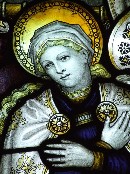 |
|
When I first wrote about
Hopton church, I was a little
patronising, perhaps. The charms of
most Suffolk churches are an open book to
all but the most casual visitors, I
noted, but some churches are more
complex, demanding time and a certain
amount of experience to decode. I
hope that I would not write such nonsense
now. Certainly, there is plenty to
explore at Hopton. But to step inside
here is to know that it is, at the very
least, merely beautiful, and probably
much more besides. In fact, there is work
here from every century from the Twelth
to the Twentieth, but it does not take an
architectural historian to enjoy the
experience of exploring it. All medieval
churches, after all, are complex, with
layers of meaning to be unlocked. If
nothing else, it is enough just to stand
and say oh, isn't it lovely!
|
And
All Saints is lovely, and apparently
little-known. I first visited it in the late
summer of 1999. I was cycling from Thetford,
through the north Suffolk borderlands, and
enjoying every minute of it. At some point, I
would have to think about turning south, if I was
to make it back to Ipswich in time for tea. But I
deferred this as long as possible, like a child
using stories to stay awake: "Just one more
church, oh go on, just one more church, and then
I'll head south - pleeeese?". The last 'just
one more' church was Hopton, and I was glad that
I gave in to myself.
The
north Suffolk villages are surprisingly large and
self-contained, compared to their soft southern
cousins. All Saints stands opposite the village
shop. You can sense, in a village like this, that
the church has a place at the heart of its
community, and I was glad to find it open. The
exterior is elegant and integrated; the south aisle is a 14th
century replacement of a 13th century one,
features of which still survive. Beyond and above
it, one of the most handsome late 15th century
brick clerestories in Suffolk
rises to nestle beneath the 18th century top of a
14th century tower. My only slight disappointment
was that the little H-shaped chimney above the
east end of the nave, which I had seen in a
photograph taken thirty years before, had been
removed.
Coming
back in 2008, nothing had changed, except the
weather. The rain was turning to stair rods as we
walked briskly up the path, but the handle turned
and I pushed the door into the deep and hushed
interior. The first impression is of one of those
relatively triumphalist High Church interiors of
the early 20th century, but in fact work of all
ages survives. The best was above out heads, one
of the most charming 15th century roofs in north
Suffolk. There is a button under the tower which
you can use to temporarily illuminate it. The
figures on the hammerbeams appear naive, as if
they might not have been intended as angels at
all. They look as if enthusiastic locals carved
them, and gave them each others faces. They carry
symbols of the Catholic liturgy; chalices,
patens, missals, etc.
The
fading colour on them is not medieval, however.
It was put on in the late 19th century by the
five daughters of the Rector, a lovely personal
response to the call of the Oxford
Movement and the ascent of Anglo-catholicism. It was
almost certainly inspired by the remarkable work
of Mildred Holland at Huntingfield. There is
something wholly human about both carving and
painting, despite the 400 years and the
Reformation that divide them.
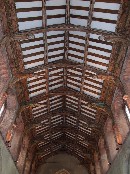 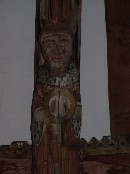 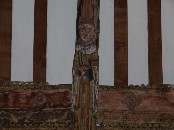 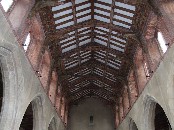 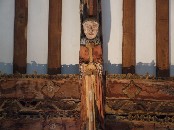
The
rood stair curves up
from within the north arcade. There are
stumps of wood cut flush with the inside of the
chancel arch; various guides describe these as
the ends of the rood beam, but they
are clearly too low. They are level with the foot
of the upper rood loft stair opening, and so are
probably something rarer; the ends of the beam
supporting the roodloft floor.
The
12th century chancel has,
unusually, two low side windows in the south
side.Why was this? Even more of a puzzle is the
glass in the east window, which Mortlock says is by
TF Curtiss for Ward & Hughes. It depicts
Christ in Majesty surrounded by the Company of
Saints, while below is a Crucifixion scene. What
makes it a little unusual is that many of the
figures have been given what appear to be the
faces real people. The Blessed Virgin and St
John, flanking the cross, are the most obvious,
but there are also late Victorian ladies taking
the guise of St Catherine, St Agnes, St Cecilia
and St Barbara. Could they be the daughters of
the couple in the Crucifixion? St Stephen may
also be based on a real person, although he looks
like nothing so much as John Henry Newman.
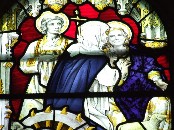 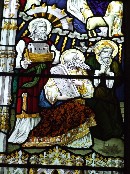 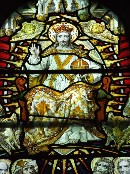
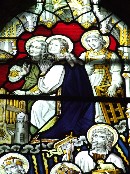 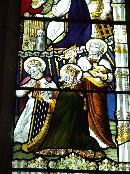
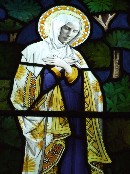 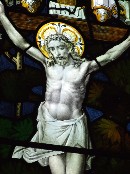 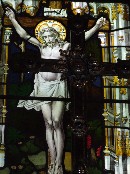 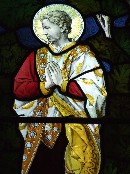 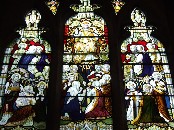
Probably
the better window is in the east end of the south
aisle, a typically rich Annunciation scene by
Kempe & Co. If Mary looks a little older than
she should, she is certainly very beautiful.
The
memorial in the chancel is signed by Thomas
Fellows of Kings Lynn, the skull at the bottom is
restrained, and yet rather eerie - its eyes, or
more exactly its sockets, seem to focus on
something beyond the present.
| At the other end of the nave,
there is a medieval door to the tower
stairs, fortified with iron like the one
at Gosbeck.
Impressive stuff. Back in 1999 I
had headed south at last, and headed back to Ipswich
through Hinderclay, Botesdale, Rickinghall
Inferior and Rickinghall
Superior, thinking them
such lovely names. In 2008, we came out
to warm spring sunshine which would not
let up all day, and headed on to the open
fields of Market
Weston.
|
|
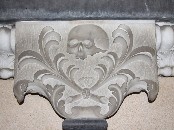 |
|
|
|

